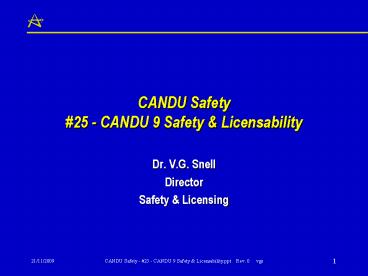CANDU Safety - PowerPoint PPT Presentation
1 / 28
Title:
CANDU Safety
Description:
... hydrogen source term (cool moderator) natural convection ... full-pressure & temperature shutdown cooling system. emergency high-pressure feedwater (Group 2) ... – PowerPoint PPT presentation
Number of Views:143
Avg rating:3.0/5.0
Title: CANDU Safety
1
CANDU Safety25 - CANDU 9 Safety Licensability
- Dr. V.G. Snell
- Director
- Safety Licensing
2
CANDU 9 Safety Licensing Requirements
- licensable in Canada
- up-front review by the AECB to ensure no
fundamental barriers - licensable in customers country
- example of dual licensability desire for
Exclusion Area Boundary lt500m led to dry
high-pressure steel-lined containment and two
independent ventilation isolation systems - meet IAEA Standards and Guides
- meet utility requirements for modern evolutionary
plant - enhanced safety
3
Heat Transport System
- one loop design (Bruce B) chosen for simplicity
- alternating channels connected to different inlet
headers to increase margins for large LOCA power
transient (interlacing) - pressurizer volume handles change from zero power
cold to full power hot - greater assurance of thermosyphoning in accidents
4
(No Transcript)
5
Feeder Connections
To outlet header
To inlet header 1
To inlet header 2
Same 480 channel core as Darlington
6
ECC System
7
ECC System
8
Grouping Separation
- defence against common cause external events
- each group must on its own
- shutdown the reactor
- remove decay heat contain radioactivity
- monitor state of the plant
- either Main Control Room (MCR) or Secondary
Control Area (SCA) can perform the above safety
functions including earthquakes - SCA needed only for major fire in MCR or hostile
takeover
9
Calandria Tubes
- increased heat transfer under accident conditions
- shot-peening of the outside surface, for Qinshan
project - black oxide on the inside surface, added for
CANDU 9 - reduces required moderator subcooling, and
therefore the size of moderator heat-exchangers
or risk of summer derating
10
Effect of Increased Heat Transfer in Accidents
nucleate boiling on peened surface
film boiling on smooth surface
11
Reserve Water Tank
- large high-elevation tank similar to CANDU 6
dousing tank supplying - ECC water, directly to sumps
- steam generator emergency feedwater
- for severe accident mitigation
- makeup to shield tank (added)
- makeup to moderator (added)
- makeup to heat transport system
12
Containment
- prestressed concrete with steel liner for
increased leaktightness robust severe accident
performance - design leakrate 0.2/day at design pressure
- no pressure suppression via dousing
(simplification) - two redundant, separated, fully independent
ventilation isolation systems - reduced exclusion area boundary (less than 500m.)
- hydrogen mitigation for severe accidents
13
Exclusion Area Boundary
Point Lepreau 914 m.
CANDU 9 lt 500 m.
14
Hydrogen Control
- small hydrogen source term (cool moderator)
- natural convection flow patterns
- no hydrogen traps
- large containment volume
- dispersed igniters
- passive recombiners
Blowout
Panels
Fuelling Machine Vaults
15
Hydrogen Mixing
16
Wetproofed Catalyst
17
Severe Accident Goals
- stop severe accident at the channel boundary
using the moderator (no fuel melting) - stop severe core damage at calandria boundary
using the shield tank (no melt-through)
18
Severe Accident Prevention and Mitigation
- Shutdown
- three methods control system two shutdown
systems - Decay heat removal
- normal auxiliary feedwater (Group 1)
- full-pressure temperature shutdown cooling
system - emergency high-pressure feedwater (Group 2)
- makeup from reserve water tank to steam
generators - moderator as emergency heat sink
- shield tank / end shield cooling
- Electrical power
- normal Class IV
- emergency Group 1 Class III
- seismically-qualified Group 2 Class III
19
CANDU Fuel Channel Cross-Section
Fuel
Pressure Tube
Gas annulus
Calandria tube
Moderator
20
Heat Rejection to Moderator in Severe Accident
21
Calandria as Core Catcher
22
Specific Water Volumes Near the Fuel
23
Calandria as Core Catcher
24
CANDU 9 - Severe Core Damage Mitigation
25
Demonstration of Licensability in Canada
- two year formal review by AECB
- gt 200 documents
- acceptance of Licensing Basis Document (Canadian
and foreign requirements) - review of design requirements, design methods,
safety analysis, probabilistic safety analysis,
QA, decommissioning, safeguards etc. - address Generic Action Items
- 13 key issues identified and eventually resolved
26
Review Focussed on Thirteen Issues
27
Licensability in Country of Origin
- The CANDU 9 design complies or can be made to
comply with licensing requirements in effect, in
Canada, on January 1, 1995 - AECL's proposals to address Generic Action Items
for the CANDU 9 design are acceptable. In all
cases the proposed method for addressing Generic
Action Items is equivalent to or an improvement
with respect to what is currently accepted on
operating CANDU reactors in Canada, and - AECL has adequately addressed the major issues
identified in the June 1996, AECB Staff Interim
Statement on CANDU 9 Licensability. - AECB staff therefore concludes that there are no
fundamental barriers to CANDU 9 licensability in
Canada
28
Conclusions
- CANDU 9 incorporates
- emerging international safety standards
- utility requirements for modern evolutionary
plant - severe accident prevention and mitigation using
inherent CANDU characteristics and passive
systems - licensability in Canada through formal AECB
review - lessons learned from licensing CANDU 6 in Asia
- CANDU 9 designed to be an internationally
licensable product































